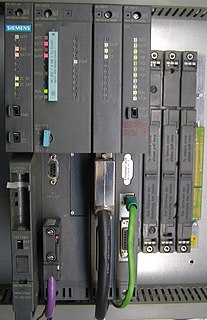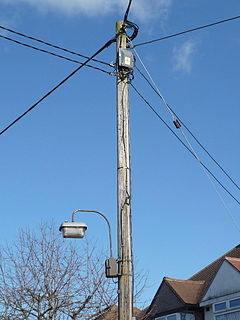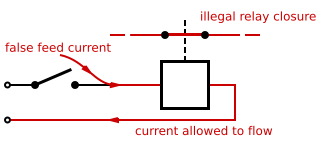
A programmable logic controller (PLC) or programmable controller is an industrial digital computer which has been ruggedized and adapted for the control of manufacturing processes, such as assembly lines, or robotic devices, or any activity that requires high reliability, ease of programming and process fault diagnosis.

A relay is an electrically operated switch. It consists of a set of input terminals for a single or multiple control signals, and a set of operating contact terminals. The switch may have any number of contacts in multiple contact forms, such as make contacts, break contacts, or combinations thereof.
In electrical engineering, a switch is an electrical component that can disconnect or connect the conducting path in an electrical circuit, interrupting the electric current or diverting it from one conductor to another. The most common type of switch is an electromechanical device consisting of one or more sets of movable electrical contacts connected to external circuits. When a pair of contacts is touching current can pass between them, while when the contacts are separated no current can flow.
In engineering, a fail-safe is a design feature or practice that in the event of a specific type of failure, inherently responds in a way that will cause no or minimal harm to other equipment, to the environment or to people. Unlike inherent safety to a particular hazard, a system being "fail-safe" does not mean that failure is impossible or improbable, but rather that the system's design prevents or mitigates unsafe consequences of the system's failure. That is, if and when a "fail-safe" system fails, it remains at least as safe as it was before the failure. Since many types of failure are possible, failure mode and effects analysis is used to examine failure situations and recommend safety design and procedures.

In electrical engineering, ground or earth is the reference point in an electrical circuit from which voltages are measured, a common return path for electric current, or a direct physical connection to the earth.

An electrical connector is an electromechanical device used to join electrical terminations and create an electrical circuit. Most electrical connectors have a gender – i.e. the male component, called a plug, connects to the female component, or socket. The connection may be removable, require a tool for assembly and removal, or serve as a permanent electrical joint between two points. An adapter can be used to join dissimilar connectors.

A circuit breaker is an automatically operated electrical switch designed to protect an electrical circuit from damage caused by excess current from an overload or short circuit. Its basic function is to interrupt current flow after a fault is detected. Unlike a fuse, which operates once and then must be replaced, a circuit breaker can be reset to resume normal operation.

A residual-current device (RCD), or residual-current circuit breaker (RCCB), is a device that quickly breaks an electrical circuit to prevent serious harm from an ongoing electric shock. Injury may still occur in some cases, for example if a human falls after receiving a shock, or if the person touches both conductors at the same time.

An Earth-leakage circuit breaker (ELCB) is a safety device used in electrical installations with high Earth impedance to prevent shock. It detects small stray voltages on the metal enclosures of electrical equipment, and interrupts the circuit if a dangerous voltage is detected. Once widely used, more recent installations instead use residual current circuit breakers which instead detect leakage current directly.

A banana connector is a single-wire electrical connector used for joining wires to equipment. The term 4 mm connector is also used, especially in Europe, although not all banana connectors will mate with 4 mm parts, and 2 mm banana connectors exist. Various styles of banana plug contacts exist, all based on the concept of spring metal applying outward force into the unsprung cylindrical jack to produce a snug fit with good electrical conductivity. Common types include: a solid pin split lengthwise and splayed slightly, a tip of four leaf springs, a cylinder with a single leaf spring on one side, a bundle of stiff wire, a central pin surrounded by a multiply-slit cylinder with a central bulge, or simple sheet spring metal rolled into a nearly complete cylinder. The plugs are frequently used to terminate patch cords for electronic test equipment, while sheathed banana plugs are common on multimeter probe leads.
In the electrical appliance manufacturing industry, the following IEC protection classes are defined in IEC 61140 and used to differentiate between the protective-earth connection requirements of devices.

Electrical wiring is an electrical installation of cabling and associated devices such as switches, distribution boards, sockets, and light fittings in a structure.

An overhead power line is a structure used in electric power transmission and distribution to transmit electrical energy across large distances. It consists of one or more conductors suspended by towers or poles. Since most of the insulation is provided by air, overhead power lines are generally the lowest-cost method of power transmission for large quantities of electric energy.
A wrong-side failure describes a failure condition in a piece of railway signalling equipment that results in an unsafe state. A typical example would be a signal showing a 'proceed' aspect when it should be showing a 'stop' or 'danger' aspect, resulting in a "false clear".

A track circuit is a simple electrical device used to detect the presence or absence of a train on rail tracks, used to inform signallers and control relevant signals.
In an electrical installation, an earthing system (UK) or grounding system (US) connects specific parts of that installation with the Earth's conductive surface for safety and functional purposes. The point of reference is the Earth's conductive surface. The choice of earthing system can affect the safety and electromagnetic compatibility of the installation. Regulations for earthing systems vary considerably among countries, though most follow the recommendations of the International Electrotechnical Commission. Regulations may identify special cases for earthing in mines, in patient care areas, or in hazardous areas of industrial plants.

A stage pin connector, also known as a grounded stage pin (GSP) or grounded pin connector (GPC), is a standard cable type for theatrical lighting in North America and in many countries in the theatre world.
Part of a railway signaling system, a slide fence is a fence whose purpose is to prevent trains from being derailed by rock slides in mountainous areas where rock slides may occur without warning. The fence is designed to be displaced by a rock slide, causing the signaling system to display a stop aspect on nearby signals. As an alternative, a structural fence is designed to physically stop falling rocks from reaching the tracks.

Automatic block signaling (ABS) is a railroad communications system that consists of a series of signals that divide a railway line into a series of sections, or "blocks". The system controls the movement of trains between the blocks using automatic signals. ABS operation is designed to allow trains operating in the same direction to follow each other in a safe manner without risk of rear-end collision. The introduction of ABS reduced railways' costs and increased their capacity. Older manual block systems required human operators. The automatic operation comes from the system's ability to detect whether blocks are occupied or otherwise obstructed, and to convey that information to approaching trains. The system operates without any outside intervention, unlike more modern traffic control systems that require external control to establish a flow of traffic.

Aerial bundled cables are overhead power lines using several insulated phase conductors bundled tightly together, usually with a bare neutral conductor. This contrasts with the traditional practice of using uninsulated conductors separated by air gaps. This variation of bundled conductors utilizes the same principles as overhead power lines, except that they are closer together to the point of touching but each conductor is surrounded by an insulating layer.















